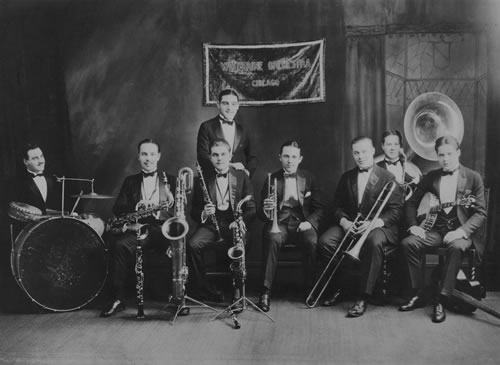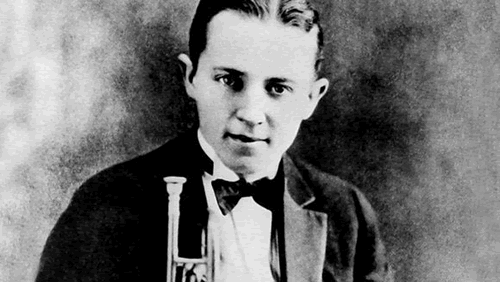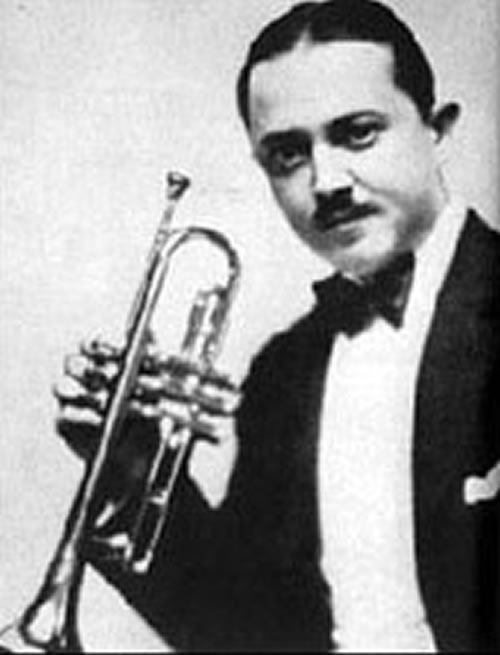Bix Beiderbecke
By: Jim Cullum, Jr.
Eddie Condon was a clever man. He quipped about the boppers, "They flat their fifths, we drink ours!" When his music was criticized by French jazz writer Hughes Panassié, he shot back, "We don’t tell him how to jump on a grape!"
But when he talked about Bix Beiderbecke, it was different. Eddie was one of the musicians who had played with Bix. They all were forever his disciples. Condon wrote about hearing Bix’s cornet for the first time: "Beiderbecke took out a silver cornet. He put it to his lips and blew a phrase. The sound came out like a girl saying yes."
That Bix sound has been described by others as "a padded mallet striking a chime" or "like pearls falling onto velvet." The sound of Bix’s horn is different. It’s a "fat" sound, broader and less strident, darker and more mellow than the others. At the same time, it is not just dark and mellow. It has a hollow ring that sometimes reminds one of a bell. Often when he bears down he gets a brass edge on the top of this. It is, for me, the most beautiful musical sound I have yet encountered.
The strength of Bix’s attack is a big part of his sound. He tends to tongue more notes (i.e., starting the sound by pronouncing the letter "T") than most cornet players. These tongued notes have little bursts that give the "striking-a-chime effect." Over a period of almost 80 years, players have attempted to figure out how he achieved these results. I have too. I have chased this elusive Holy Grail for my entire life as a musician. Like many other Bix-influenced players, I don’t want to simply copy Bix. But I do listen to the master playing in my head, and sometimes I work to see just how fat the sound can get.
To a degree, Bix’s magical tone was helped along by the equipment he used. Much of his playing was on Conn Victor cornets. All the old Conns–reeds and brass–were a little heavier and had rich tones, and the bore size of the Victor Cornets was extraordinarily large. The standard bore size for cornets and trumpets is 460 thousandths of an inch. The standard for large bore horns is 468 thousandths of an inch. The Conn Victor bore was 484 thousandths of an inch. Most modern trumpet players have never seen, or even heard of, a horn larger than 470. And, Bix mostly used an old-fashioned cornet mouthpiece that was deep and open, compared to the modern ones. This large bore and open mouthpiece would cause any cornetist to sacrifice some endurance and some upper register accessibility. The payback is an enriched tone.
From listening to his recordings, I can guess that Bix must have played with his upper and lower teeth fairly apart and his jaw relaxed. This created a larger oral cavity as if to say, "Aw." He must have had a forward embouchure that caused him to put a lot of "meat" into the mouthpiece. It sounds like he moved all this with a lot of air. You can hear his good health and vitality at work. Remember, he was only 24 or 25 years old when he did his greatest playing. No doubt he did these physical things unconsciously, because most of the sound he created was a result of the sound he heard in his head.
He had perfect pitch, and his abilities to apply it were phenomenal. In fact, it has been reported that on numerous occasions on a dare or a bet, he could turn his back and have someone bang out a big 10-note chord on the piano–with the notes in any combination. Then, starting at the bottom and going up, he would name every note in the chord. As any musician will tell you, this is an incredible and seemingly impossible feat.
Layer all this God-given talent over Bix’s ringing tone and attack and you’re halfway there. The rest of the story is the way he improvised–the way he strung the notes together. For Bix was among the most creative and intelligent improvisers in jazz history. Time after time, every performance was new and fresh, as he selected the most interesting notes and intervals. His work was not filled with overwhelming virtuosity. Rather it tended, upon analysis, to be perfectly composed, as though he had spent weeks playing and replaying his solos. Of course, he just tossed them off!
It is amazing that even from his teenage beginnings Bix understood and completely applied musical economy. His goal was to make every note say something. Automatic fingering patterns, full of throwaway notes, were avoided. Sometimes this approach is found in the mellowness of a mature, and therefore extra thoughtful artist. It is almost never combined with the exuberance of youth, as in Bix’s playing.
In all this Bix found his unique voice. A personal stamp, instantly recognizable, is often present in the playing of the self-taught jazz musician. And Bix learned to play with countless trial and error attempts. He applied the "lick system:" Play one short pattern a few times, then another and another, in repeated variations over and over until they can be strung together in longer phrases. This was for him the easy way. Also, Bix was not under the tutelage of any professor who demanded scales and etudes. He practiced little ideas and melodies that came to him as he sat fascinated with the result of his own creativity. There were great rewards for him in this self-styled practice, so of course he spent a lot of time at it. Along the way, Bix’s sheer musical intelligence made him gradually gain considerable technique. He could play fast, but was too lost in the quality of his instant new melodies to use music merely to display his technique.
A part of Bix’s approach to music came from his family and hometown. It came from his boyhood. Much of the story is well known: Bix was from "the heartland," the Midwest farm state of Iowa, the small town of Davenport. His background was one of some privilege. His family lived in comfort in Davenport. He was well educated, at least through high school. He was reasonably handsome. He was white.
All of this–the safe small town, the security, the birthright, the supportive family–gave Bix the room to dream and to practice without specific requirements. In many respects it was luxury, with Bix having no hard goals except the vague one of seeing how far he could take it all.
His family was dismayed, not by his obvious musical talent or his pursuit of it, but by his fascination with a new "low class" music: jazz. Those of us who have come after Bix can easily see the quality of the great art he continues to pour out to us. But Bix’s frustrated parents saw only a life of tragedy. In many ways they were right. They had taken delight in their young son’s amazing ability to create a little quick music at the piano. They had given encouragement. But now, this jazz was different! There was a wildness in it, and they sensed danger. Bix’s father and mother began to pull in a new direction, away from music. Bix was sent away to Lake Forest Academy, an expensive private school near Chicago. It had a reputation for producing ranks of the model citizens the Beiderbeckes wished their son to join.
But it was too late. Bix had tasted the thrill of realizing his abilities to create magnificent music on the spot; this spoke to him and those around him; it said: "Come on! This is life!" He would chase this sweetness to the end. As the years began to slide by, his family hoped against hope that he would somehow grow up and enter a life of "real work and success." They withheld any words of praise for Bix’s amazing accomplishments. They turned colder as Bix chased his addictions–his addiction to creating jazz improvisation and his growing addiction to alcohol. Sadly, Agatha and Bismark Beiderbecke misunderstood their son’s musical obsessions. They gave their love, which was deep and abiding, but they stubbornly withheld their approval.
One telling incident repeated through the years has become a part of the Bix mythology. As Bix rose to the top of his profession, he made about 160 recordings. It is through these recordings that we are now able to gain access to the Bix mind and the Bix music. He regularly sent copies of his finished records to his parents’ home in Davenport, and it was there, during a period when he attempted to escape the horrors of advancing alcohol addiction, that he retreated.
One day he accidentally discovered all the records he had sent home. They were stored in the back of a hall closet, in their original packages–unopened. Of course, this hurt Bix deeply. Still, throughout his life Bix had great love and respect for his parents and his siblings. His letters home to them have now been published and they make obvious this love.
 |
Bix probably would have experienced a similar pattern regardless of his parents’ resistance or encouragement. He seemed to have a built-in streak of melancholy in his music and in his life. This bittersweet quality, often not noticed when one first begins listening to Bix, may be the most intriguing ingredient. For while the Beiderbecke sound is filled with joy–and it is hot and it is swinging–it often carries a subtle sadness.
Bix died in 1931. He was 28. His body was shipped back to Davenport for burial. In death he was again enfolded into the bosom of his family, and his grave is there in the dignified Beiderbecke family plot. To family members the day closed the saddest chapter of their lives. His grave is beside his mother Agatha Beiderbecke, and a marker shows her date of death as 1952.
One can’t help indulging in a little fantasy: By 1952 the world had come to regard Bix as one of the towering figures of American music. As the cult of admirers grew from a clutch of jazz musicians to a small army worldwide, as Columbia Records in 1946 and 1947 re-issued his work in album form, as critics almost universally cited him as an incomparable genius, and as some highly creditable musicians began unabashedly to speak of him as one of the most inspiring figures, not just of jazz or music, but of all art, what must Agatha Beiderbecke have thought?
It is hard to imagine that she could not have finally taken great pride in her son’s work, which completely eclipses all that was done by all the combined Beiderbecke clan and its progeny. She might at first have been amazed at all the fuss, but as it continued and intensified over the twenty-one years that she lived after Bix died, she knew, if nothing else, how the world clamored for her son’s music.
However, as the Beiderbecke home on Grand Avenue was sold, Agatha went quietly to spend her last years at a downtown Davenport hotel and left no record of how her feelings might have changed.
The groundswell of admiration and affection for Bix has never slowed. In 1971, on the 40th anniversary of Bix’s death, a group of jazz musicians traveled from New Jersey to Davenport and played over Bix’s grave. This was a wake-up call to some in Davenport. The next year a Bix Beiderbecke Memorial Festival was begun there, and it has grown to be a huge annual event, drawing thousands to downtown Davenport every July.
A common pattern prevails in the Bix story. It is often easier to see our great men and women from a distance, well past their lives. Bix is now a world figure. Residents of Davenport, while they often know little about the music, are now keenly aware that Bix is by far the most famous product of their city.
The Bix landmarks in Davenport are like shrines. Pilgrims from around the world visit. Usually, they start with Bix’s grave. Then there is the Beiderbecke home on Grand Avenue, the Presbyterian church where Bix was baptized, an old upstairs school of dance where Bix played his first gig, and the high school Bix attended before his transfer to Lake Forest Academy.
Other interesting old ballrooms are there with similar claims to fame: Bix played there! There is a statue of Bix, and a major thoroughfare has been named Bix Beiderbecke Drive. Every year some 20,000 long distance runners gather in Davenport to race in Bix’s name!
A Bix Beiderbecke Memorial Society runs the annual festival, maintains an office and provides "Bix Lives" shirts, stickers, and buttons. The Davenport Library greets the faithful who look over a few old photographs and documents. The Putnam Museum displays Bix’s cornet. You can even get a "Bix burger" at a popular downtown restaurant.
During the last 75 years, it doesn’t seem there has been much economic oomph to Davenport. This must be lamented by many citizens there, but to the Bixophile it makes the place a Mecca. It mostly remains as Bix last saw it, just sitting there slowly rotting, but it’s there. Street after street contains Victorian frame houses similar to the Beiderbeckes’. Even Bix’s grandfather’s imposing home still stands proudly on one of the Davenport hills. The central business district is largely unchanged. It is easy to picture Bix emerging there, a fresh, bright, energetic young man, his mind happily flooded with interesting melodies.
The legend continues. Around the world more people are listening to Bix each year. Every recording he made is now available online–even every alternate take.
It is strange that some in Davenport still lag behind the rest of the world. City fathers there, in the face of ever mounting interest in Bix and his hometown, still seem mostly disinterested and are even slow to support the annual festival. To some, Bix’s music, so compelling, ranks with the greatest artistic works of history. To others it is just "some old music."
But the streets and buildings of Davenport speak to the dreamer in us, just as Bix’s horn very clearly speaks across the years. Many of us feel that through his music we know him personally, even though he died years before we were born.
Story taken from Jim’s blog at : http://www.jimcullum.com/blog2.html.
Photo 1 – famouscomposers.net – Bix & Cornet
Photo 3 – Wikimedia.org – Wolverine Jazz Band


